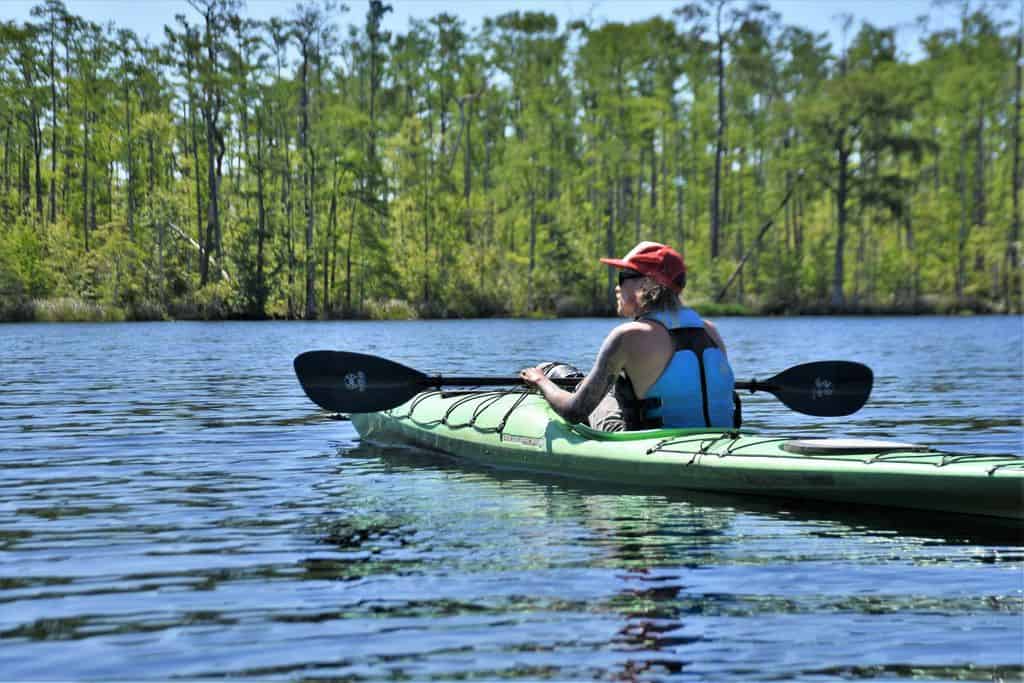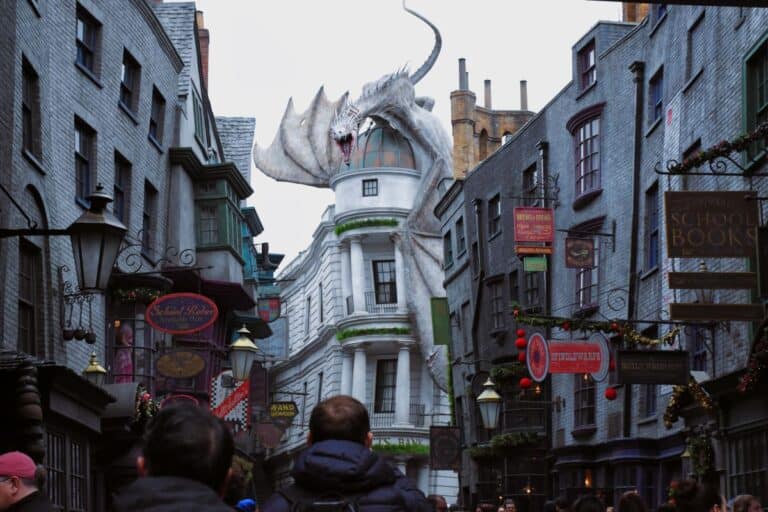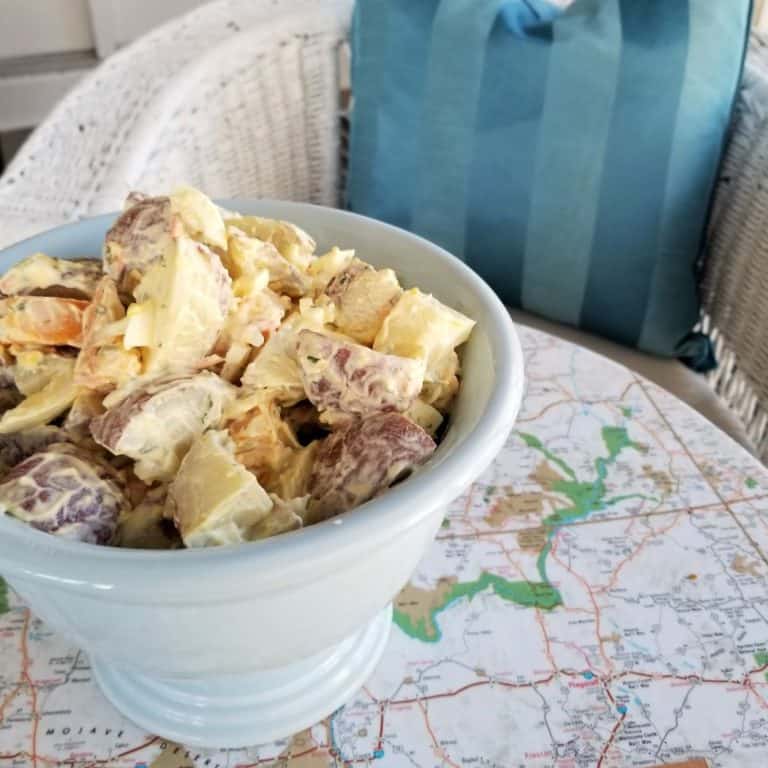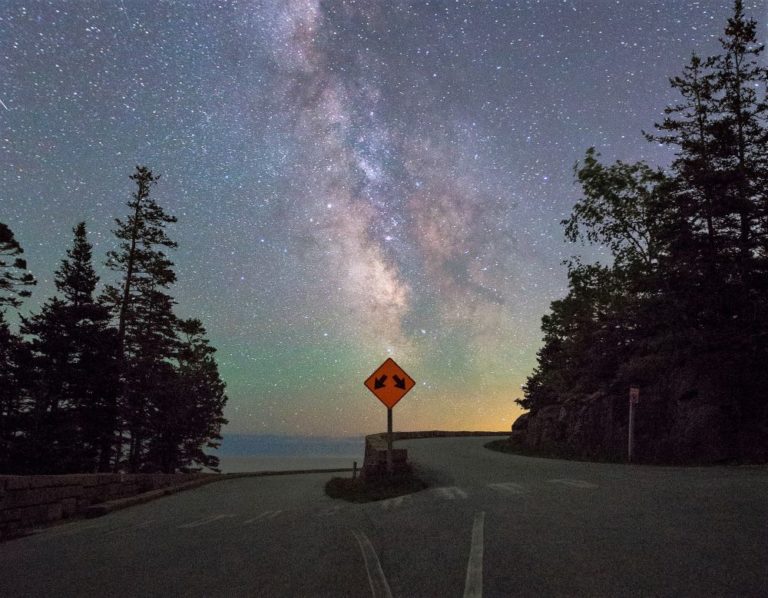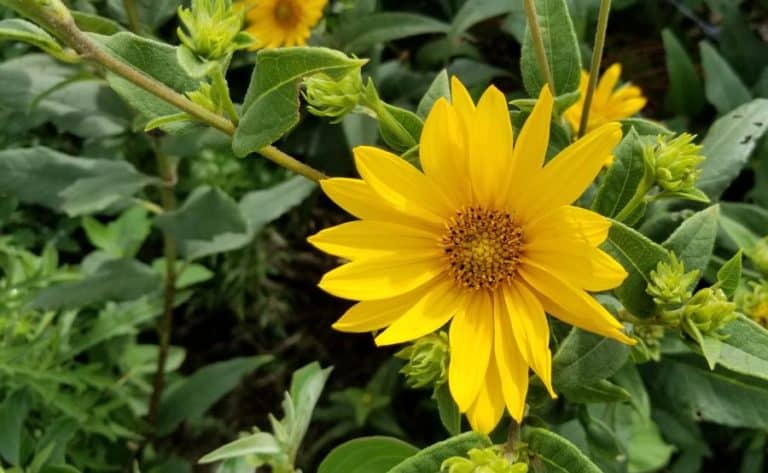10 Best Places to See Outer Banks Wildlife
This site contains affiliate links to products or services that I recommend. Any purchases made through these links don’t add anything to your purchase price. It helps me keep the lights on and bring you quality travel tips. As an Amazon Associate, I earn from qualifying purchases. Thanks so much for your support!
Do you have a Bucket List of Outer Banks wildlife that you want to see in their natural habitat? You may be surprised that wildlife in the Outer Banks of North Carolina may include many of the unique animals on your list. Imagine seeing alligators, black bears, sea turtles, whales, and more in the same region. If you’re a bird-watcher, you’ll think you’re in heaven since this area is an integral part of the Atlantic Flyway bird migration route.
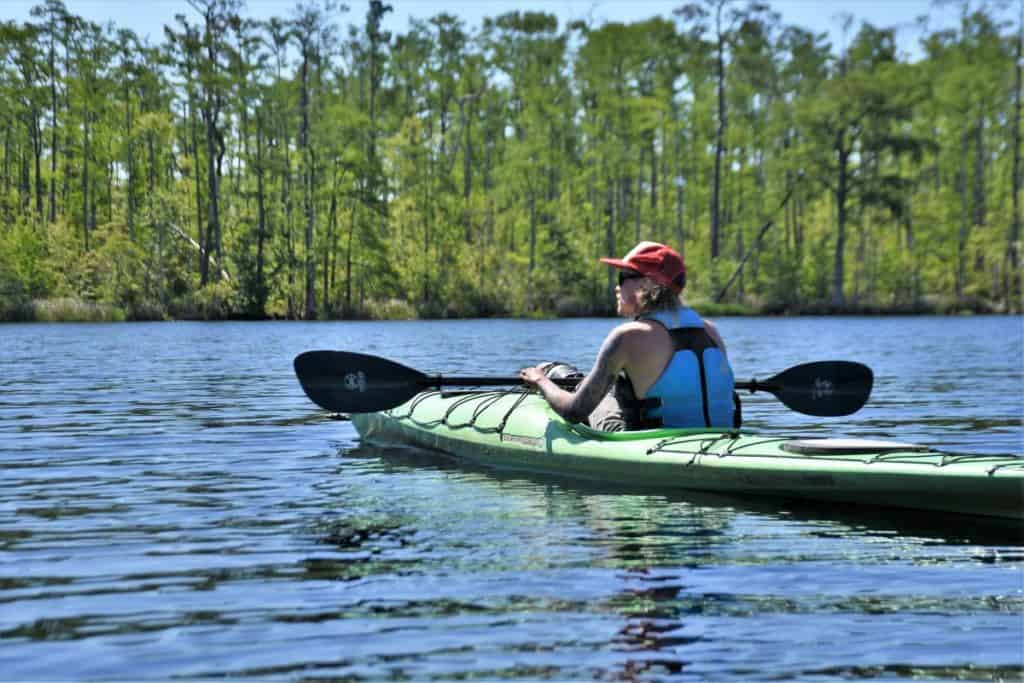
North Carolina’s Outer Banks barrier islands protect over 300 square miles (777 sq. kilometers) of uninhabited nature preservation areas. wild spaces set aside to help you get away from the pressures of life. This is a nature photographer’s and bird watcher’s paradise. These areas offer extraordinary experiences in wild and unspoiled land where you can decompress, observe, explore, photograph, document, and learn about an abundance of Outer Banks wildlife and nature.
Map of Outer Banks Protected Wildlife Areas
I created this Google map to help you find the best places for Outer Banks wildlife viewing in North Carolina. You’ll see a variety of sites, including National Wildlife Refuges and North Carolina State Parks and Preserves. The first National Seashore established in America, lighthouses, and other trails and beaches are all worth visiting. If you click on the icon in the upper left of the map you’ll be able to see the name for each location. Click on a site and you’ll see the location pin highlighted and more info about the destination.
Currituck Banks Reserves
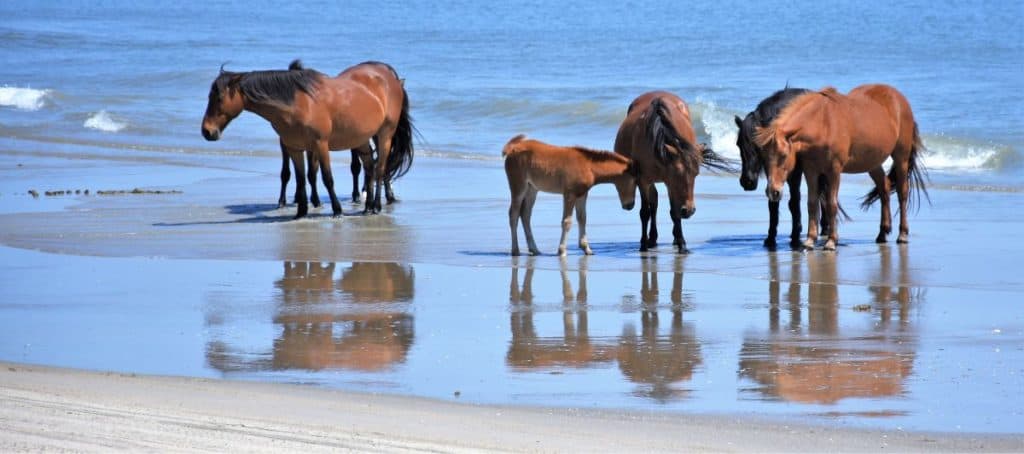
Currituck Banks Coastal Reserve and Currituck Banks National Estuarine Reserve– Corolla, North Carolina
These two reserves are in close proximity to each other and are a bird watcher’s paradise. The land is an important stop along the Atlantic Flyway where migrating birds take a breather in spring and fall. It’s also estimated that 32% of North Carolina’s waterfowl spend their winters in Currituck. The Currituck Banks Coastal Estuarine Reserve is excellent for bird watchers in any season so it’s been designated as a part of the North Carolina Birding Trail System. You may see owls, hawks, and bald eagles overhead or herons, egrets, and kingfishers wading in the marshes.
The Reserve also includes a unique maritime forest which is one of the rarest habitat types on the East Coast. I love the gorgeous canopies of the Live Oak trees. In addition to the many birds, you may also see the beautiful Corolla Wild horses, muskrats, nutrias, river otters, and minks. Add white-tailed deer, gray foxes, raccoons, opossums, and even occasional feral hogs to your Outer Banks wildlife list. PRO TIP: Most animals are active in the mornings and evenings.
How to Get to Currituck Banks Reserves
As you can imagine, the reserve is a pristine wilderness with very little, if any, access to vehicles. Your best bet for visiting is to set your Google Map to the Currituck Banks Maritime Forest Trail Head (see my map above). Or head north from Corolla on NC Highway 12 to the curve in the road just before the spot where the paved part of the highway turns into the beach. Please don’t drive on the beach unless you have a 4-wheel drive vehicle! Towing fees can be pricey and could take hours.
Just before the road hits the sand, you’ll see a small parking lot on the left side of the road. This is the trailhead for the handicapped and stroller-accessible “Boardwalk and Sound Overlook Trail”, 2/3 mile (1 km) round trip. Plus, if you’re looking for a great spot to watch the sunset over the Currituck Sound, this is the place. You may even see a few of Corolla’s wild horses silhouetted against the sunset, so bring your camera. This easy hike also has benches to rest and interpretive signs along the way to learn more about the nature that’s surrounding you.
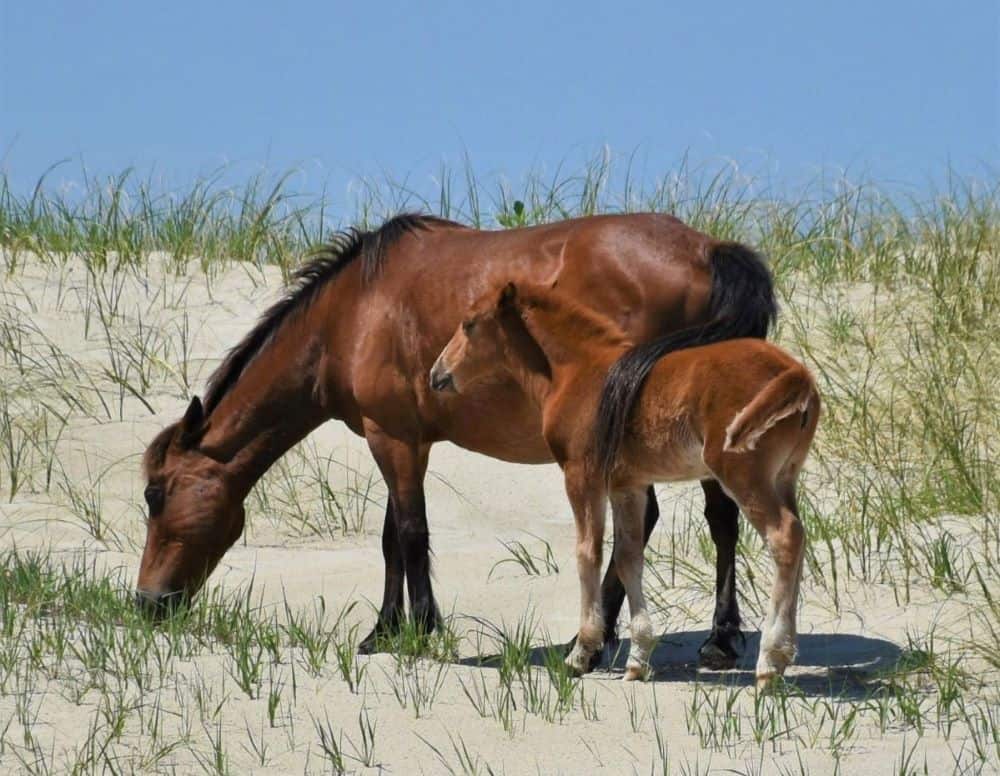
Currituck National Wildlife Refuge
As I’ve mentioned, getting to the protected land in the northern part of the Outer Banks is a tricky situation. As you drive north along NC Highway 12 past the town of Corolla you’ll soon reach a spot where the road turns from pavement to sand. If you don’t have a 4-wheel drive vehicle, DO NOT drive onto the sand! Tow truck companies have probably earned millions by pulling cars with ignorant or arrogant drivers out of this sandy stretch of “Highway” 12. Yes, it’s actually an official highway.
The easiest way to see the Currituck Wildlife Refuge, Outer Banks wildlife, and the wild horses (if you don’t want to rent a 4-wheel drive vehicle or get stuck in the sand) is to book a 4-wheel-drive tour with one of the wild horse tour companies in Corolla. Tours are generally 2 hours, but if you’re a photographer check out the extended 4-hour nature photography tour with the only company that offers them (Back Country Safari). The extra time around sunset and the lower number of people allow space to bring your camera equipment and time to capture some great shots. The tour guide, Nathan is also extremely knowledgeable, helpful with photography tips, and expert at finding the horses and other wildlife in the area.
To see other Outer Banks wildlife, visit right after sunrise or just before sunset. You’ll get spectacular photographs of shorebirds, waterfowl, and raptors. Walk through the interior of the island (access is restricted to foot traffic only) and admire the dune structure, dune vegetation, and maritime forest.
Visit the Monkey Island tract, a noted bird rookery to see the beach grasses, gorgeous live oak, loblolly pine, wax myrtle, sedges, cattails, and rushes that make this the ideal nesting habitat for several species of wading birds.
What are the Rules for Outer Banks Wild Horses?
The ‘Corolla Wild Horses’, are feral mammals that were left on the island hundreds of years ago. They’re not original inhabitants of the Outer Banks. While they may look tame, don’t approach them. Humans and pets are legally required to stay at least 50 feet from the horses. You can be arrested or hurt if you try to touch them.
For the safety and health of the horses, please don’t feed them anything. Their digestive systems are used to a diet of only grasses, so even things that you feed your horse at home like apples, could make them sick or even kill them.
Your pets must be on a leash or properly confined at all times.
Vehicle access is limited to the Monkey Island and Swan Island tracts and is by four-wheeled vehicle only. Signs delineate the Refuge boundaries, closed areas, hunting, and archery zones as well as a Hunter Access Route. All signage must be obeyed for safety and natural resource protection purposes.
Carry-in, carry-out is the policy for waste and trash on all protected lands. Take only pictures and leave only footprints. Be sure to bring bug spray, sunscreen, and drinking water. There are no restroom facilities at Currituck National Wildlife Refuge.
Alligator River National Wildlife Refuge (ARNWR)
The Alligator River Refuge is not technically part of the barrier islands of the Outer Banks, but is right next door, and many people pass through on their way to the islands. The refuge is on a peninsula that covers 237 sq. miles (615 sq km) of natural habitat. It’s bordered by the freshwater Alligator River, the brackish Albemarle Sound, and shallow mix of salt and fresh water in the Pamlico Sound. Depending on which direction you come from in North Carolina, two of the main highways that take you to the Outer Banks pass through ARNWR. It’s one of the more exceptional settings for diverse wildlife viewing in America.
Endangered Red Wolves in the Outer Banks
Outer Banks wildlife is truly unique! This refuge is one of the only places in the world where the endangered Red Wolf is being reintroduced in the wild. In the 1980s this wolf was declared extinct in the wild, but with the help of a captive breeding program that was started from Red wolves in captivity, there are now about 40 Red wolves wandering in the refuge.
Red wolves are smaller than the Gray wolf and bigger than a coyote. They are mostly brown and buff-colored with some black along their backs, often with a reddish color on their ears, head, and legs. They’re not easy to spot but if you do they may have a tracking collar around their neck. For some family fun check out the ranger-led “Red Wolf Howling Safari” that’s open to all ages. You’ll learn about these mammals and the program to bring them back then head for the heart of the refuge to listen for their eerie howls.
Encounter an American Alligator in OBX
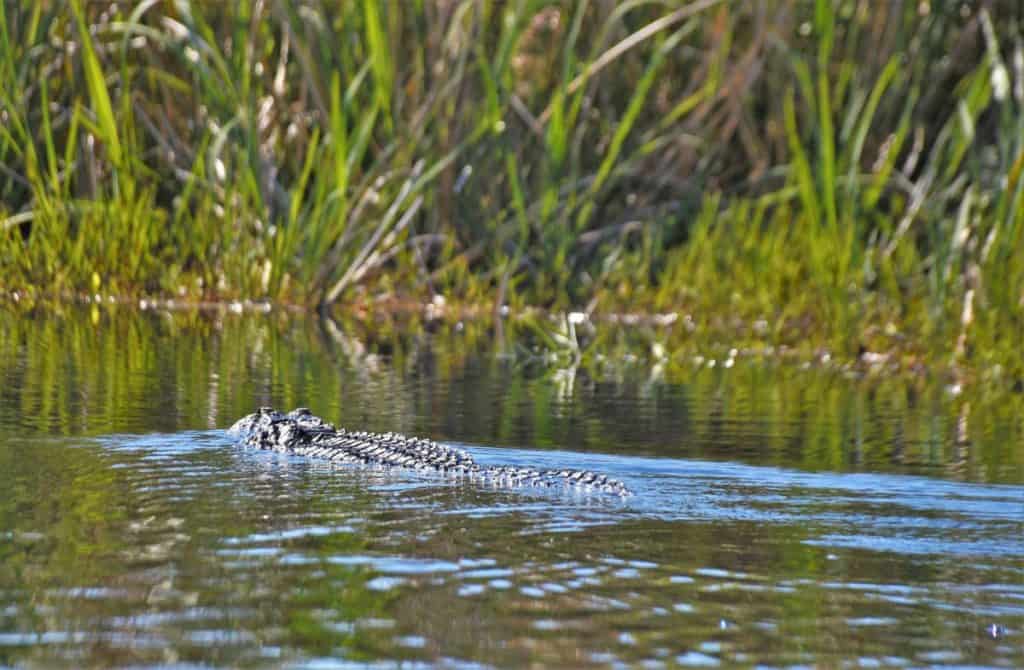
You WILL also find American Alligators here in the Outer Banks (hence the name Alligator River). This area is the northernmost range for these reptiles. They may not be a big as some you see in Florida, but they’re still awe-inspiring. I learned that the number of cold weather days limits their “growing season” and their ability to survive and reproduce, so colder winters make smaller gators.
My husband and I took a two-and-a-half-hour morning Guided Kayak Tour in May and saw this rascal above. Our guide, Scotty said he was about 7 feet long. The animal was minding his own business, swimming along near the edge of the river in front of our kayaks in an area they call Alligator Alley. Along the beautiful water trails, we also saw several turtles sunning themselves on logs, majestic Bald Cypress trees, and some gorgeous deep purple Irises along the banks.
No Lions or Tigers, but Black Bears – Oh My!
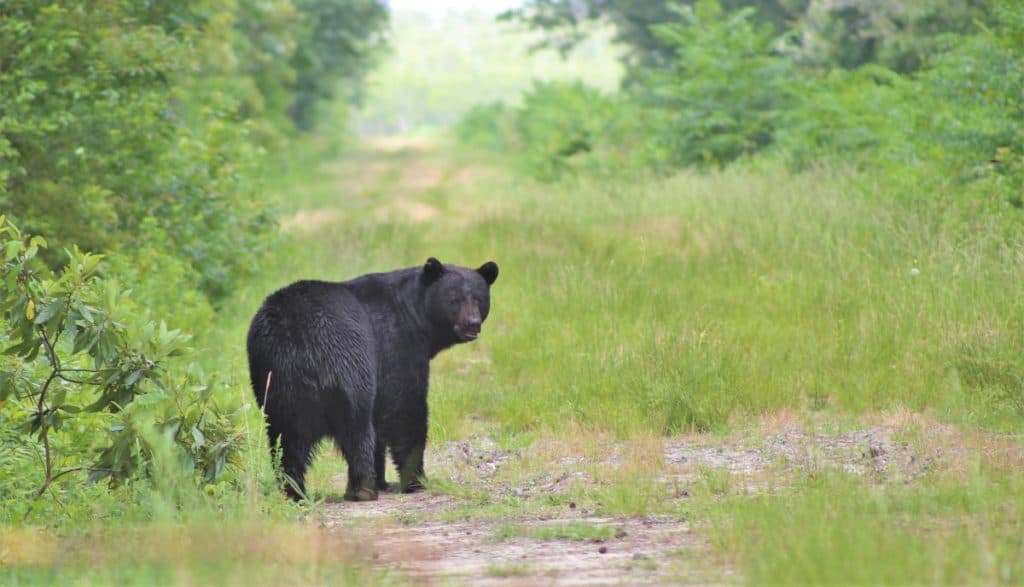
You might be surprised that you’ll also find the highest concentration of Black Bears in the country and the largest black bears in size too. That’s primarily because they don’t hibernate as much as bears in colder climates so they’re eating nearly year-round. In fact, you might not even have to enter the refuge. If you drive along US 264 and US 64 you might spot small black bears lounging along the highway.
Things to do at Alligator River NWR:
- Start your visit at the Coastal NC National Wildlife Refuges Gateway Visitor Center – 100 Conservation Way, Manteo, NC 27954. This Visitor Center represents eleven national wildlife refuges and one national fish hatchery in Eastern North Carolina. You’ll find interactive exhibits, audio-visual programs, and even virtual airplane rides and field trips to the different sites.
- The refuge also offers hiking on nature trails, exploring the waters at Milltail Creek paddling trails, geocaching, strolling on the pristine beaches, and many chances to practice your nature photography skills.
- Take a drive on the Murphy Peterson Wildlife Drive in the morning before 10 a.m. or evening around dusk to look for black bears, alligators, white-tail deer, turtles, a plethora of birds, and reptiles from the safety of your vehicle. When we were there we saw a couple of raccoons and a gorgeous owl. I think we were a little too early in the day to see Black bears, but I’ve heard from people who’ve seen 4 or more in one evening.
- Are you a bird watcher? Find your favorites and share your sightings with the eBird Trail Tracker.
- Guided tours and scheduled programs can include ranger-led canoe, van, and open-air tram tours of the refuge.
Buxton Woods Coastal Reserve
Buxton Woods Coastal Reserve – Water Association Road, Frisco, NC 27936
This natural area is one of 10 sites that make up the North Carolina Coastal Reserve & National Estuarine Research Reserve. Roughly 1,000 acres (405 hectares) of land was set aside on Hatteras Island to protect the unique coastal ecosystem.
Within this Outer Banks wildlife reserve, you can see the only maritime shrub swamp in the world and keep your eye out for two rare butterflies (northern hairstreak and giant swallowtail). The striking dark chocolate brown and yellow Giant Swallowtail is the largest species of butterfly in North America. They have a wingspan of 6 inches, so shouldn’t be hard to miss.
The low spots between the sand dunes create interdune freshwater ponds and wetlands known as sedges. This seasonal water brings a large number of amphibians and reptiles. Look for frogs, toads, salamanders, turtles, and snakes (some poisonous).
Over 350 species of migrating birds rest in the reserve, especially in the fall. Look for bald eagles, osprey, peregrine falcons, and wood ducks, to name a few. You can also spot larger animals, like opossum, fox, river otters, rabbits, and deer if you’re patient.
Buxton Woods Coastal Reserve Map
Before you visit download the Buxton Woods Coastal Reserve map to give you the lay of the land. You’ll find the reserve between the towns of Frisco and Buxton. Some trailheads require a 4-wheel drive vehicle because of the sandy terrain, so plan ahead. You’ll find that some of the trails connect with Cape Hatteras National Seashore too. Some seasonal hunting is allowed on the reserve, so check with the North Carolina Wildlife Resources Commission for seasons and regulations.
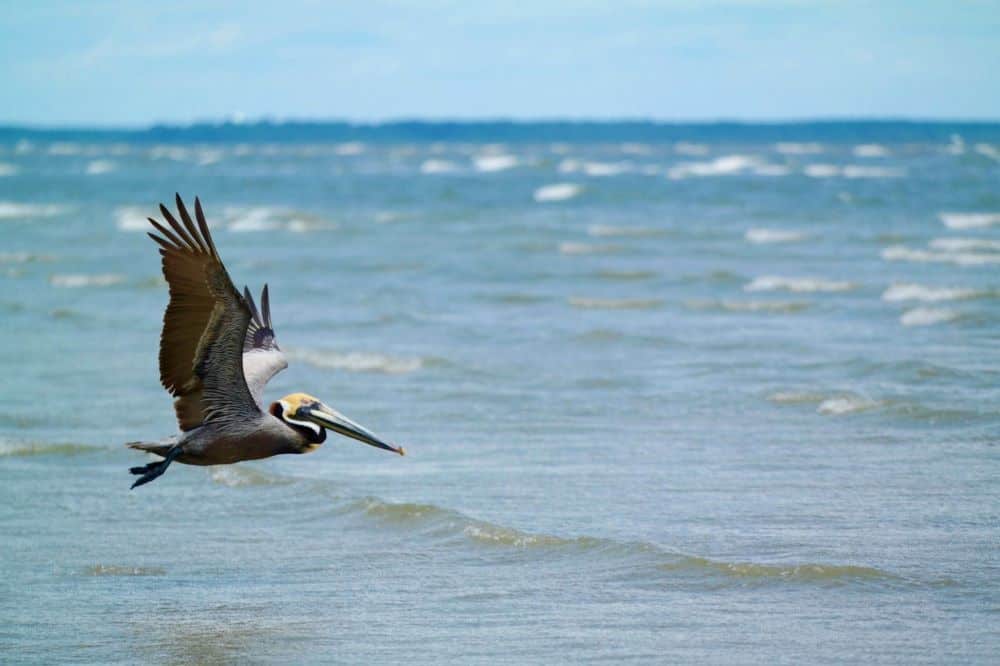
Cape Hatteras National Seashore
Cape Hatteras Island Visitor Center – 46375 Lighthouse Road, Buxton, North Carolina 27920
Ocracoke Island Visitor Center – 38 Irvin Garrish Highway, Ocracoke, North Carolina 27960
Cape Hatteras National Seashore covers 44 square miles (115 sq km) and has 4 different Visitor Centers where you can learn about nature and wildlife in this protected space. It was designated as America’s first National Seashore in 1953. In addition to its famous lighthouses, you’ll also find nesting grounds for sea turtles. White-tail deer, harbor seals, and a myriad of birds of all shapes and sizes inhabit the land as well. A variety of reptiles make appearances at Cape Hatteras – including lizards, snakes, alligators, and land turtles.
Cape Hatteras offers excellent fishing opportunities of all kinds. Book a charter ocean fishing trip to chase marlin and sailfish in the “Billfish Capital of the World”. Spend the day at the world-famous Avon Fishing Pier. Fishermen on the pier have recorded many record catches. The giant Red Drum can weigh more than 40 pounds, and you don’t even need a fishing license there. Hatteras Inlet is also a favorite spot for surf fishing. If you’re a pier fisherman you can choose from nearly a dozen different piers located from Kill Devil Hills to Hatteras.
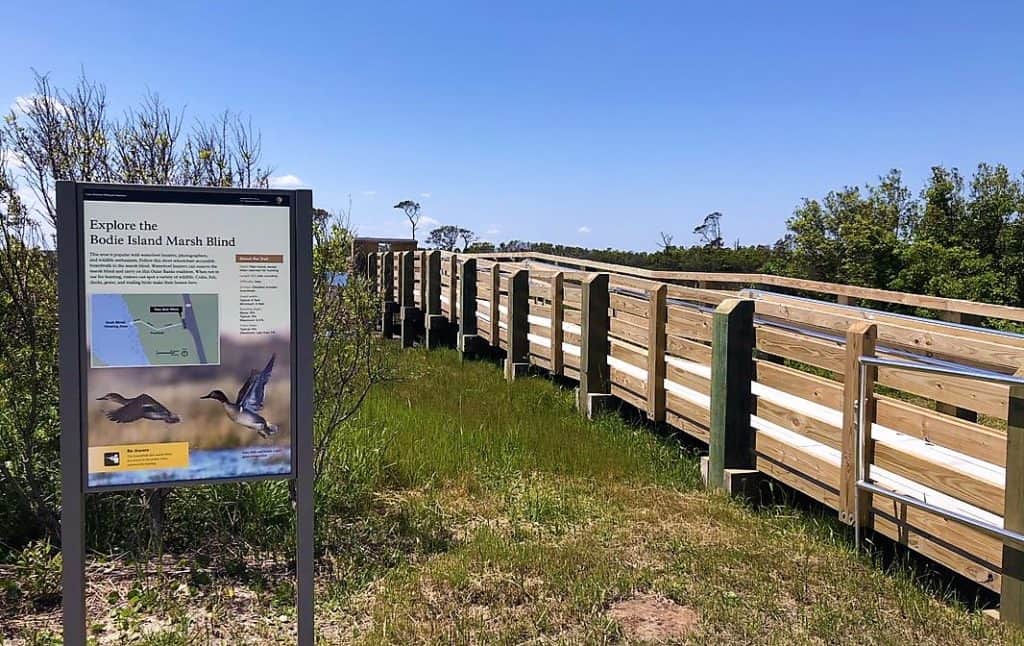
Bodie Island Marsh Blind
Ask a ranger at one of the Visitor Centers if the wildlife-viewing platform at Bodie Island Marsh Blind is open. It’s about two miles north of the Bodie Island Light Station on Highway 12. This is a great spot for bird-watching. From December through March, the wildlife-viewing platform also serves as an accessible hunt blind for duck and waterfowl hunters with limited mobility. Hunters have to reserve it in advance, so don’t just drop in.
The Bodie Island Marsh Blind is open for Outer Banks wildlife viewing from April 1 through the middle of November (with a few exceptions in October). The blind provides a great opportunity to experience the calm marshes of the Outer Banks and observe the unique plants and animals that call the ecosystem home. Here are a few of the animals that may be seen from the blind.
Birds
- Waders (great egret, snowy egret and great blue heron)
- White ibis
- Osprey
- Northern harrier (during fall/winter months)
- Waterfowl (mostly fall/winter): black duck, mallard, bufflehead, red breasted merganser, common merganser and pintail
- Bald eagle
Reptiles
- Black racer snake
- Snapping turtle
- Mud turtle
- Yellow-bellied slider turtle
Wild Ponies & Camping at Cape Hatteras Nat’l Seashore
You’ve probably heard of the wild horses at the northern edge of the Outer Banks in Corolla. Did you know about the Ocracoke Horses on Ocracoke Island? They’re probably not as well-known because they’re a little harder to get to. The island is only reached by the free ferry.
Cape Hatteras National Seashore has four campgrounds within the park. All of the campgrounds have tent, trailer, and motor home sites. Visiting the beach comes with potential hazards. Learn the simple steps you can take to improve your safety. Reservations for all campgrounds must be made using the links to www.recreation.gov listed below. Sites may be available the day of your visit, but you must pay for your site on www.recreation.gov.
Fishing in the Outer Banks
The best fishing is in the spring and fall, but the dedicated fisherman can easily catch all year. Fishing action during the middle of summer is best offshore. Regardless of when you visit check out which fish are biting best in which months in North Carolina.
The Outer Banks is “The Billfish Capital of the World,” and for good reason. Hundreds of blue marlin, white marlin and sailfish are caught and released in our waters every year. The billfish season is long, with the peak for blue marlin in June and white marlin and sailfish most seen in August and September. Another big draw is yellowfin tuna, which are caught year-round. Anglers don’t need a license for charter boats and pier fishing.
Hatteras Island Ocean Center
Hatteras Island Ocean Center – 57204 North Carolina Highway 12, Hatteras NC 27943
The Hatteras Island Ocean Center is a part of the Outer Banks National Scenic Byway, which stretches across North Carolina’s Bodie, Hatteras, and Ocracoke islands, Down East, and the Pamlico Sound. Hampden-Sydney College and the Center partner with the local community, students, and volunteers on citizen science projects. They also offer Outer Banks wildlife conservation learning opportunities for visitors.
Some of the programs at the Ocean Center:
- Kayak nature tours in the wetlands and Pamlico Sound,
- Join a turtle patrol to learn about sea turtles and search for active nests,
- Take a walk through the salt marshes and learn about this unique ecosystem.
- You can bring the kids to create s’mores around a campfire, be awed by the Milky Way in some of the darkest skies of OBX and search for ghost crabs after dark.
If you want to explore on your own, launch your kayak, canoe, or stand-up paddleboard from their public water access. Sandy Bay and Slash Creek are great places to explore nearby. You can also go crabbing for Blue Crabs right from their boardwalk!
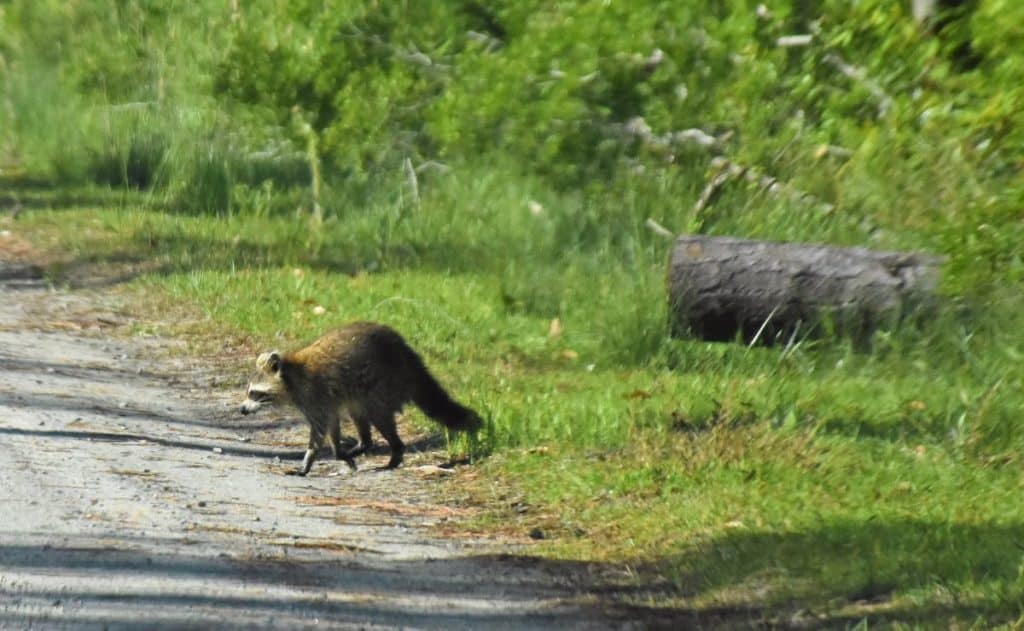
Nags Head Woods Preserve
Nags Head Woods Preserve – 701 West Ocean Acres Drive in Kill Devil Hills NC
Nestled between the Wright Brothers National Memorial and Jockeys Ridge State Park is Nags Head Woods Preserve. These 1400 acres (5.6 sq km) of protected maritime forest are filled with towering oaks, canopied ridges, ponds, marshes, and wetlands along the shores of Roanoke Sound. If you’re a wildlife lover look for white-tailed deer, both gray and red fox, raccoons, mink and river otters.
Among the list of Outer Banks wildlife, you’ll see birds of every shape and size in the preserve. From the majestic Great Blue Heron to the petite Ruby-throated Hummingbird. More than 550 plant species and 50 kinds of butterflies in a rainbow of colors also make their home in Nags Head Woods. You can see some butterflies year-round, but late spring through early fall are the best times to see them at Nags Head Woods. The preserve offers five miles of trails including an ADA accessible and stroller-friendly trail for those with limited mobility. This trail passes the butterfly garden, freshwater fishing area and views of the Roanoke Sound.
Throw in your line and relax while fishing (catch and release only) on the platforms in the preserve. Be sure anyone 16 and older has a North Carolina fishing license. Drop your line in the water for freshwater fishing on the Discovery and ADA trails. You can enjoy saltwater fishing at the end of the Roanoke Trail in the waters of the Sound.
You may bring dogs, bikes, and horses on the gravel roadway, but not on the hiking trails.
Pea Island National Wildlife Refuge
Across the Sound from Alligator River is Pea Island NWR. It covers 9+ square miles (24 sq km) with the Atlantic Ocean to the east and the Pamlico Sound to the west. This ribbon of mostly sand and grass provides unspoiled habitat for more than 365 species of migratory birds that use OBX as a stopover on their way further south or as their winter home. This is one of North Carolina’s most popular birding destinations and one of the state’s premier sites for rare or unusual sightings of shorebirds, waterfowl, raptors, and many others.
Loggerhead turtles use this and other beaches of the Outer Banks and North Carolina coast as nesting grounds. Occasionally, you’ll see other sea turtles like the Leatherbacks, Green sea turtles, or Kemp’s Ridley turtles coming on the beach to lay eggs. Starting in May and continuing through August, female sea turtles lay their eggs on North Carolina beaches, usually at night. Each nest, or clutch, contains about 120 eggs, roughly the size of a ping pong ball. The eggs incubate under the warm sand for 60 to 100 days, depending on the weather. Then the tiny turtles hatch and instinctively head for the water.
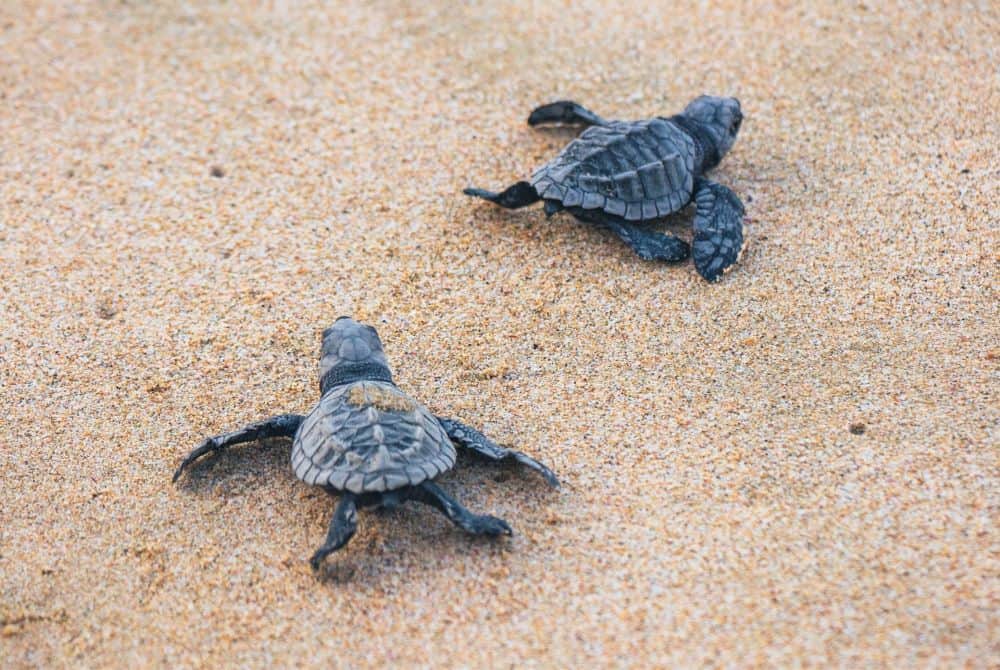
Sea Turtles Preservation Programs
The Network for Endangered Sea Turtles (N.E.S.T.) and the Outer Banks Marine Mammal Stranding Network (OBX MMSN) manage programs to monitor and protect these nesting sites. If you love nature and plan to be in the Outer Banks in the summer for more than a month, consider becoming a volunteer to help with monitoring sea turtle activity.
Outer Banks wildlife viewing is popular from the Pea Island Visitor Center (14500 NC Highway 12, Rodanthe, NC 27968) and along the two wildlife trails on the refuge. Species of birds change with the season, so there is almost always something new to see. Fish, rays, sea turtles, and dolphins can also sometimes be seen from the beach.
Fishing is allowed in the ocean and the sound at Pea Island. Oregon Inlet between Bodie & Pea Islands is a popular spot for surf fishing and a starting point for fishing charters. Surf season starts in March and peaks in May and November. Surf fishermen can choose from over 100 miles of shoreline to reel in their catch. Camping, hiking, swimming, nature observation, photography, fishing, and stargazing are just a few of the activities you can enjoy in these areas.
Important Tips for Outer Banks Wildlife Viewing
Be aware of the possibility of poisonous plants and venomous snakes, and keep your distance.
Dogs are sometimes allowed on trails in protected areas, but check the rules at each location. In most cases, you’ll be required to keep them on a leash and ALWAYS clean up after them.
Where Can I Find Guided Outer Banks Wildlife Tours?
With so much nature and wildlife to see in the Outer Banks, there’s no shortage of tours available. Check out Viator to get great prices on boat rides to see dolphins or whales, a variety of kayak tours, hang gliding, 4-wheel drive tours to see the wild horses, and tons more.
Booking your trip? Here are some of the resources I use myself:
-Book great deals on flights with Cheap-o-Air
-Discover cool lodging with Booking.com
-Find the best prices and perks for cruises at CruiseDirect.com
-Reserve your vacation home rental with VRBO
-Book your car rental with RentalCars.com
-Buy your travel insurance with InsureMyTrip
-Book unique travel tours with Get Your Guide and Viator
-Find delicious culinary experiences with EatWith
-Find even more of my favorite travel resources here.
When you use these links I earn a small commission, at no extra cost to you. This helps me pay the bills and allows me to continue to create and share free tips and advice to help you travel better. As an Amazon Associate I earn from qualifying purchases.
What Should I Bring?
Bring plenty of drinking water, sunscreen, and insect repellent, especially during the summer months. The marshes are breeding grounds for mosquitoes. It’s all part of the circle of life. A sun hat is helpful for skin protection, too, but make sure it’s one that will stay on your head if it’s windy.
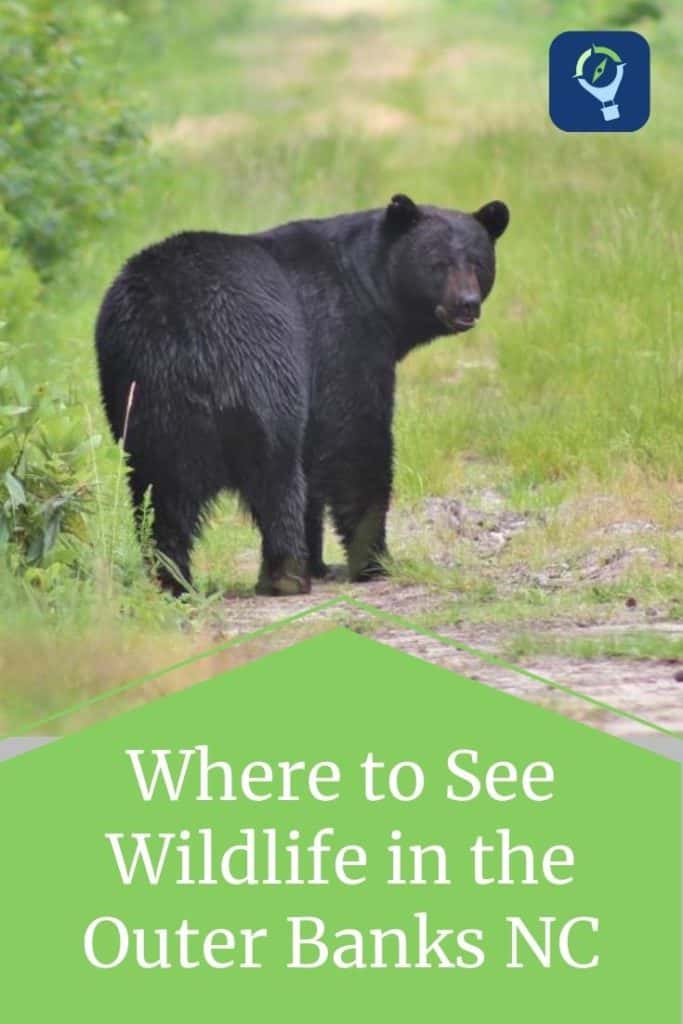
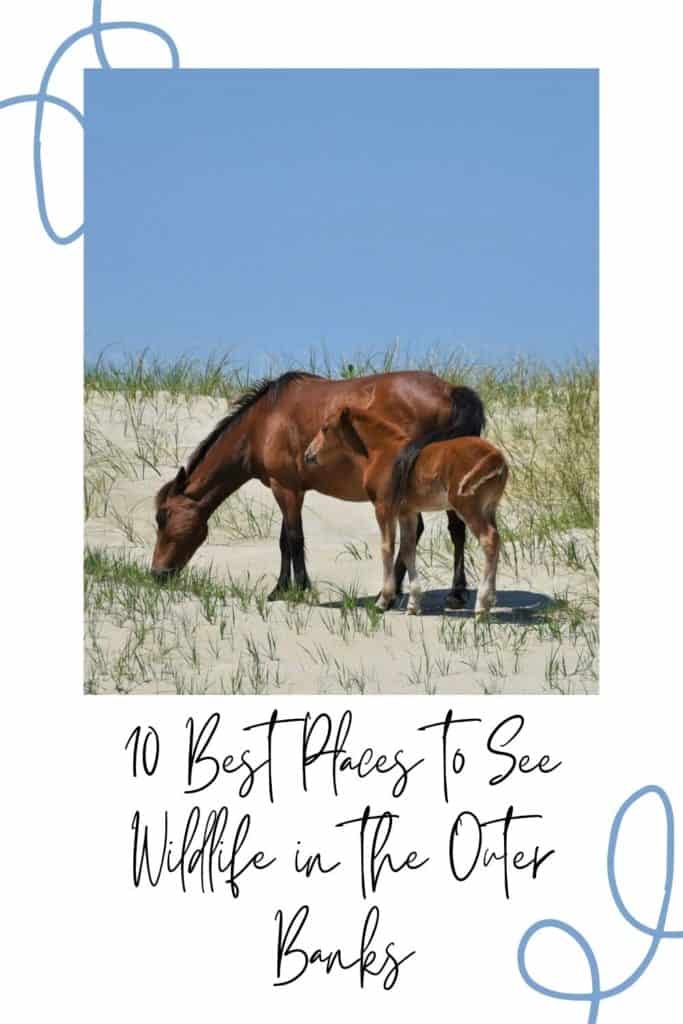
Want to plan a North Carolina road trip in addition to seeing Outer Banks wildlife? Then check out my suggestions on great places to travel in North Carolina.

